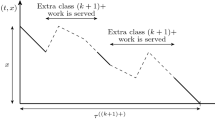Abstract
We investigate a Markov modulated fluid queueing system with strict priority. The input process is composed of two fluid flows which are stored in buffer‐1 and buffer‐2, respectively. The rates of these fluid flows depend on the current state of a finite state Markov chain. Buffer‐1 has full assignment of priority (=strict priority) for service and so buffer‐2 is served at a residual service rate when buffer‐1 is empty. We explicitly derive the stationary joint distribution of the two buffer contents in the system by a spectral decomposition method. In the case of a two‐state Markov chain, the joint distribution is explicitly expressed in terms of the system parameters. Also the joint moments and tail distributions of the two buffer contents are obtained and some numerical examples are presented.
Similar content being viewed by others
References
J. Abate and W. Whitt, The Fourier-series methods for inverting transforms of probability distributions, Queueing Systems 10 (1992) 5-88.
D. Anick, D. Mitra and M.M. Sondhi, Stochastic theory of a data-handling system with multiple sources, Bell System Tech. J. 61 (1982) 1871-1894.
K.E. Atkinson, An Introduction to Numerical Analysis (Wiley, New York, 2nd ed., 1988).
R. Bellman, Introduction to Matrix Analysis (McGraw-Hill, New York, 2nd ed., 1970).
J.W. Cohen, Single Server Queue (North-Holland, Amsterdam, 1982).
N.G. Duffield, Exponential bounds for queues with Markovian arrivals, Queueing Systems 17 (1994) 413-430.
A.I. Elwalid and D. Mitra, Fluid models for the analysis and design of statistical multiplexing with loss priorities on multiple classes of bursty traffic, in: Proc. IEEE INFOCOM '92 (1992) pp. 415-425.
A.I. Elwalid and D. Mitra, Effective bandwidth of general Markovian traffic sources and admission control of high speed networks, IEEE/ACM Trans. Networks 1 (1993) 329-343.
A.I. Elwalid and D. Mitra, Analysis, approximations and admission control of a multi-service multiplexing system with priorities, in: Proc. IEEE INFOCOM '95 (1995) 463-472.
D. Mitra, Stochastic theory of a fluid model of producer and customers coupled by a buffer, Adv. Appl. Probab. 20 (1988) 646-676.
M.F. Neuts, Matrix Geometric Solutions in Stochastic Model (Johns Hopkins Univ. Press, Baltimore, 1981).
F.L. Presti, Z.L. Zhang and D. Towsley, Bounds, approximations and applications for a two-queue GPS system, in: Proc. INFOCOM '96 (1996) 1310-1317.
T.E. Stern and A.I. Elwalid, Analysis of separable Markov-modulated rate models for information handling system, Adv. Appl. Probab. 23 (1991) 105-139.
T. Tanaka, O. Hashida and Y. Takahashi, Transient analysis of fluid model for ATM statistical multiplex, Performance Evaluation 23 (1995) 145-162.
G. de Veciana, G. Kesidis and J. Walrand, Resource management in wide-area ATM networks using effective bandwidths, IEEE J. Selected Areas Commun. 13 (1995) 1081-1090.
J. Zhang, Performance study of Markov modulated fluid flow models with priority traffic, in: Proc. IEEE INFOCOM '93 (1993) pp. 10-17.
Author information
Authors and Affiliations
Rights and permissions
About this article
Cite this article
Choi, B.D., Choi, K.B. A Markov modulated fluid queueing system with strict priority. Telecommunication Systems 9, 79–95 (1998). https://doi.org/10.1023/A:1019138226866
Issue Date:
DOI: https://doi.org/10.1023/A:1019138226866



